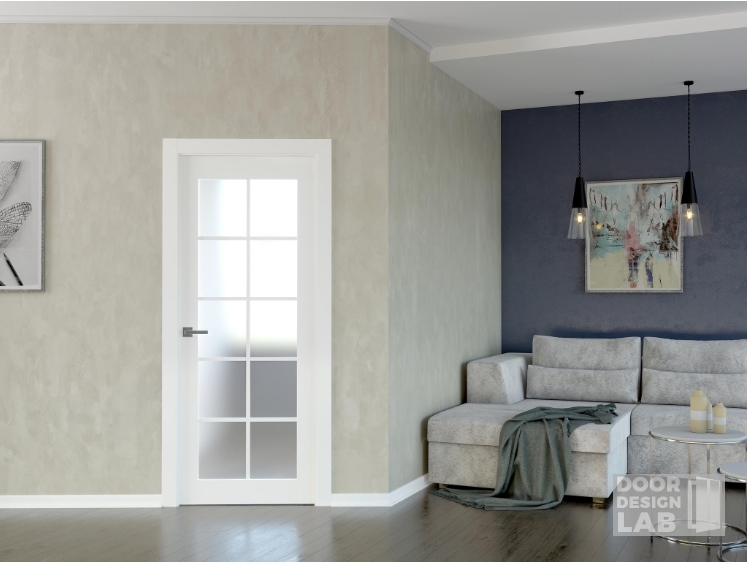
Let’s address the elephant in the room: typical plain, hollow core doors are not only cheap, but they also look kind of cheap as well. There is nothing wrong with simplicity, but one should try to make the home look more pleasing to the eyes, and plain doors don’t often meet the standards.
If you have a dull, plain hollow-core door in your home, it is time for you to transform it into a beautifully paneled door. Here, you’ll learn how to turn your plain door into an attractive paneled door to give your home a more modern and elegant touch without spending a lot of money. We’ll be discussing one of the best ways you can transform the look of your plain door and how you can dress it up. Let’s get started:
Applying Panel Molding
If you have a builder-grade, slab-style door in your home, you can dress it up by using frames of molding to give it a look of a traditional door. All you have to do is pick a profile that matches the existing trim of your home and recreate the look of any panel style that you feel is going to look good.
Tools You’ll Need
- Flathead screwdriver
- Phillips-head screwdriver
- Miter Saw
- Combination Square
- Clamps
- Framing Square
- Mallet
- Rounded Chisel
- Pneumatic Nail Gun
What You Need To Do
Pop off the door from its frame and set it in your workstation. You’ll need to remove the hinge pins by using a flathead screwdriver. To guide you, we are going to choose a traditional four-panel design that uses heavy nose-and-cove molding, which goes with the built-up door casing.
Shop for the following items:
- One 1/8-by-1 3/4-inch poplar nose-and-cove molding. You should get four 8-footers
- 18-gauge 1-inch nails for pneumatic nail gun
- Wood putty
- Wood glue
- 120-grit sandpaper
- Latex primer and paint
- And a new lockset (if needed)
Step 1: First of all, you need to draw the outline directly on the door. Mark the outside styles of the panel frames by using a combination square, and then you need to draw the perpendicular rails. In other words, it will mark your door with three of the four sides of each panel frame.
Step 2: Set up the miter saw and adjust the blade to 90 degrees. Rough cut 16 blanks to length (each one will be used for each side of each panel). Now change the blade to 45 degrees to have the left-hand miter and cut one end of all the pieces. Reset the blade to make the opposing miters. Cut one rail to size and make sure you do check the length against the layout of the door.
Step 3: Now, you need to set up a stop block to ensure that you make all the rails identical. Clamp a piece of scrap to the fence of the saw, lower the blade and bring the piece of molding flush against it. Make sure you mark where the other end meets the scrap and clamp a block at that location. Once you do it, simply position each piece against the block before making the cut. Reposition the stop block for each length of molding and cut the rest of the pieces using the same technique.
Step 4: With all molding that is already cut, you can move on to installation. Lay out the four pieces of a panel on the lines you drew earlier. Dry fit the panels on the line and apply wood glue to the back of each piece and place them on the lines. It is best that you start with the outside style and then move on to installing the two rails. This way only the inside style is left and there is no need to worry because it fits flawlessly between the exposed ends of the rails.
Step 5: Many people face difficulties in getting a perfect fit at the mitted corners. Here is a trick for you. Take nail gun and nail through the mitted corners (make sure you do it from the outside edges of the corner). Do it from one molding to another before you nail the length of molding to the door.
Step 6: If there is excess glue, don’t wipe it off. Look for any gaps in the mitted corners. If you find the gaps (most probably you will), apply wood putty. It is best that you fill all the holes and nails with wood putty.
Step 7: Now, you need to sand away any rough spots. Use the 120-grit sandpaper.
Step 8: If you want to install the door lock as well, you’ll need to either buy the same lock or a different type. For instance, if you decide on installing lever handle on the door then it’ll need a larger mortise. To make the mortise, first you’ll need to set the door on the edge on the floor. Then, trace the outline of the latch and use the drill to chuck a large bit from the door. The hole should be 1/8 inch deep at each corner. Use the chisel and mallet to clean out the hole and remove any excess material. Assemble the lockset and screw it in the place.
Step 9: As you have done all the work, it is time to use good-quality latex paint to match the molding to the door. Do it slowly and give it a few hours to dry off, or you can rehang the door straightaway as well. There you have it – now you have given a traditional and more elegant look to your simply, boring plain door.
The Bottom Line
Upgrading the plain door to panel door not only gives a more elegant and pleasing look to the home but it is also fun. If you are new at it, we’d recommend you to practice this on an old door before you start transforming all the other plain doors of your house. You’ll become good at it over time with patience and commitment. Keep practicing and have lots of fun.
We also recommend:
- How To Fix A Door That Won't Stay Open Or Closed
- How to fix an interior door that won't close
- How to fix loose interior door hinges
- How to fix a sagging interior door
- How to fix a tight interior door
- How To Repair A Damaged Hollow Core Door
- Some Tips and Solutions on How to Avoid Door Warping
- How to fix or replace a door frame
- How to fix a squeaky door
- The Most Common Interior Door Problems and How to Fix Them

